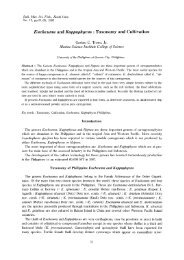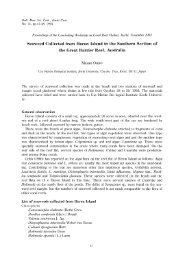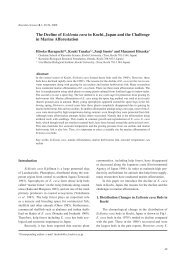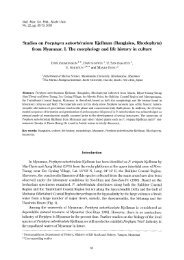Thyroid carcinomas incidentally found in the cervical lymph nodes ...
Thyroid carcinomas incidentally found in the cervical lymph nodes ...
Thyroid carcinomas incidentally found in the cervical lymph nodes ...
You also want an ePaper? Increase the reach of your titles
YUMPU automatically turns print PDFs into web optimized ePapers that Google loves.
* ManuscriptClick here to download Manuscript: Text(Yamamoto)081407.doc<strong>Thyroid</strong> <strong>carc<strong>in</strong>omas</strong> <strong><strong>in</strong>cidentally</strong> <strong>found</strong> <strong>in</strong> <strong>the</strong> <strong>cervical</strong> <strong>lymph</strong> <strong>nodes</strong>- Did <strong>the</strong>y arise from <strong>the</strong>heterotopic thyroid tissues?Tetsuya Yamamoto, DDS, PhD, Yukihiro Tatemoto, DDS, PhD, Yukiko Hibi, DDS, AkihikoOhno, DDS, PhD, and Tokio Osaki, DDS, PhDDepartment of Oral and Maxillofacial Surgery,Kochi Medical School, Kochi UniversityKohasu, Oko-cho, Nankoku-city, Kochi, 783-8505, JapanCorrespond<strong>in</strong>g author: T. Yamamoto,Department of Oral and Maxillofacial Surgery,Kochi Medical School, Kochi UniversityKohasu, Oko-cho, Nankoku-city, Kochi 783-8505, JapanTEL: +81-088-880-2423, FAX: +81-088-880-2424E-mail address: yamamott@kochi-u.ac.jp1
ABSTRACTPurpose: <strong>Thyroid</strong> <strong>carc<strong>in</strong>omas</strong> have been <strong><strong>in</strong>cidentally</strong> <strong>found</strong> <strong>in</strong> <strong>the</strong> <strong>cervical</strong> <strong>lymph</strong> <strong>nodes</strong> dur<strong>in</strong>goperation of head and neck squamous cell carc<strong>in</strong>oma (SCC) and such <strong>carc<strong>in</strong>omas</strong> have beenconsidered metastatic.Patients and Methods: We encountered 3 cases of <strong>in</strong>cidental papillary carc<strong>in</strong>oma <strong>in</strong> <strong>the</strong> neck ofpatients with oral SCC and reviewed 75 cases previously reported.Results: Papillary <strong>carc<strong>in</strong>omas</strong> were <strong>found</strong> <strong>in</strong> 3, 10 and 3 <strong>lymph</strong> <strong>nodes</strong> <strong>in</strong> cases 1, 2 and 3,respectively. CT exam<strong>in</strong>ation revealed 2 tumor-like shadows and 1 calcified mass <strong>in</strong> <strong>the</strong> cases 2and 3, respectively.These shadows did not enlarge dur<strong>in</strong>g <strong>the</strong> 3 to 5 years of observation and allpatients have been alive without any event at <strong>the</strong> neck and thyroid gland. In reviewed cases,approximately two-fifths were histopathologically or cl<strong>in</strong>ically free from thyroid carc<strong>in</strong>oma.Conclusion: We proposed a possibility that occult thyroid carc<strong>in</strong>oma is not necessarily metastaticbut occasionally arises from <strong>the</strong> heterotopic thyroid tissues.2
periodically observed without thyroidectomy. He has been alive without any adverse event for 11years.Case 2A 67-year-old man was referred to our cl<strong>in</strong>ic for treatment of T4N2bM0 SCC of <strong>the</strong> tongue.He underwent partial glossectomy and <strong>cervical</strong> neck dissection. The histological exam<strong>in</strong>ationrevealed metastasis of <strong>the</strong> tongue SCC to 2 <strong>lymph</strong> <strong>nodes</strong> at level I (Table 1).Besides <strong>the</strong>metastatic foci of SCC, papillary carc<strong>in</strong>oma was <strong><strong>in</strong>cidentally</strong> <strong>found</strong> <strong>in</strong> 3 and 7 <strong>lymph</strong> <strong>nodes</strong> at levelsII and III, respectively (Fig. 2A and 2B).The degree of development of <strong>the</strong> papillary <strong>carc<strong>in</strong>omas</strong>differed among <strong>the</strong> <strong>in</strong>volved <strong>lymph</strong> <strong>nodes</strong>. Two tumor-like foci with a diameter of approximately5 mm <strong>in</strong> <strong>the</strong> thyroid gland were detected on CT exam<strong>in</strong>ation. <strong>Thyroid</strong>ectomy was however notperformed because of <strong>the</strong> patient’s unwill<strong>in</strong>g. The tumor-like shadows have been static dur<strong>in</strong>g 5years after <strong>the</strong> surgery.Case 3A 54-year-old man visited our cl<strong>in</strong>ic for <strong>the</strong> exam<strong>in</strong>ation and treatment of tongue tumor.For <strong>the</strong> treatment of <strong>the</strong> tongue SCC (T4N2M0), he underwent chemo-radio-immuno<strong>the</strong>rapy as did<strong>in</strong> case 1. After remission of <strong>the</strong> tumor, partial glossectomy and bilateral neck dissection wereperformed. Metastasis of <strong>the</strong> glossal carc<strong>in</strong>oma to multiple <strong>lymph</strong> <strong>nodes</strong> at bilateral levels I andIV and contralateral level III was observed histopathologically (Table 1). Papillary <strong>carc<strong>in</strong>omas</strong>were also detected at levels III and IV, <strong>in</strong> a total of 3 <strong>lymph</strong> <strong>nodes</strong> (Fig. 3A).A CT exam<strong>in</strong>ation of<strong>the</strong> thyroid gland was carried out with<strong>in</strong> 10 days after <strong>the</strong> surgery and a small calcified mass with a5
All foci of <strong>the</strong> papillary carc<strong>in</strong>oma <strong>in</strong> a total of 16 <strong>lymph</strong> <strong>nodes</strong> were positive forthyroglobul<strong>in</strong> but <strong>the</strong> SCCs (exam<strong>in</strong>ed as <strong>the</strong> control for <strong>the</strong> papillary <strong>carc<strong>in</strong>omas</strong>) were fullynegative for thyroglobul<strong>in</strong> (Table 2, Figure 4). Of <strong>the</strong> kerat<strong>in</strong>s exam<strong>in</strong>ed, cytokerat<strong>in</strong> 13 (aubiquitous cytokerat<strong>in</strong>) and total kerat<strong>in</strong> (AE1/AE3) were observed <strong>in</strong> all <strong>carc<strong>in</strong>omas</strong> (Figure 5) andcytokerat<strong>in</strong> 18, which is expressed particularly <strong>in</strong> gland tissues and columnar cells, was expressed <strong>in</strong>15 of <strong>the</strong> 16 papillary <strong>carc<strong>in</strong>omas</strong> <strong>in</strong> <strong>the</strong> <strong>lymph</strong> <strong>nodes</strong> and 1 of <strong>the</strong> 8 metastatic SCCs (Figure 6) butoral SCCs were fully negative for cytokerat<strong>in</strong> 18.These immunohistochemical results <strong>in</strong>dicatedthat <strong>the</strong> papillary <strong>carc<strong>in</strong>omas</strong> possessed prote<strong>in</strong>s characteristic of thyroid carc<strong>in</strong>oma and that <strong>the</strong>existence of cytokerat<strong>in</strong> 18 was <strong>in</strong>dicative of <strong>the</strong> gland tissue orig<strong>in</strong>.Review of literaturesWe reviewed 10 articles on occult thyroid carc<strong>in</strong>oma that was <strong><strong>in</strong>cidentally</strong> <strong>found</strong> <strong>in</strong> <strong>the</strong><strong>cervical</strong> <strong>lymph</strong> <strong>nodes</strong> of patients with <strong>the</strong> head and neck SCC. 1-10The primary SCCs were locatedwith equal frequency <strong>in</strong> <strong>the</strong> oral cavity (<strong>in</strong>clud<strong>in</strong>g <strong>the</strong> lips) and larynx but rarely located <strong>in</strong> <strong>the</strong>pharynx and o<strong>the</strong>r sites (Table 3).Of <strong>the</strong> <strong>in</strong>cidental thyroid <strong>carc<strong>in</strong>omas</strong>, 49 were papillary typeand 26 were follicular type (mixed type was observed <strong>in</strong> 12 cases), and solid type was <strong>found</strong> <strong>in</strong> 2cases (<strong>the</strong> histological type was not shown <strong>in</strong> 6 cases).<strong>Thyroid</strong>ectomy <strong>in</strong>clud<strong>in</strong>g lobectomy wasperformed <strong>in</strong> 48 glands and 26 glands of <strong>the</strong>se glands revealed carc<strong>in</strong>oma on <strong>the</strong>ir histopathologicalexam<strong>in</strong>ation but <strong>the</strong> rema<strong>in</strong><strong>in</strong>g 22 glands were negative for carc<strong>in</strong>oma.Fourteen patients who didnot undergo thyroidectomy were fully negative for thyroid carc<strong>in</strong>oma cl<strong>in</strong>ically dur<strong>in</strong>g <strong>the</strong>7
observation periods.In 13 patients, <strong>the</strong>ir thyroid status was not noted.The levels and number of <strong>lymph</strong> <strong>nodes</strong> with occult thyroid carc<strong>in</strong>oma are <strong>in</strong>sufficientlydescribed <strong>in</strong> literatures (<strong>the</strong> description of <strong>the</strong> levels and number are limited to a fewliteratures) 4,5,7,10 (Table 4). In <strong>the</strong> 16 cases with a sufficient description, occult thyroid carc<strong>in</strong>omawas observed <strong>in</strong> 42 <strong>lymph</strong> <strong>nodes</strong> (mean number = 2.5 <strong>lymph</strong> <strong>nodes</strong>/case). Among <strong>the</strong> levels, levelIII was most commonly <strong>in</strong>volved (19 <strong>lymph</strong> <strong>nodes</strong>), followed by level IV (14 <strong>lymph</strong> <strong>nodes</strong>) andlevel II (9 <strong>lymph</strong> <strong>nodes</strong>).Three cases revealed an <strong>in</strong>volvement of level II with no carc<strong>in</strong>oma ato<strong>the</strong>r levels of <strong>lymph</strong> <strong>nodes</strong>. 4,7,10DiscussionCervical <strong>lymph</strong> <strong>nodes</strong> are frequently <strong>in</strong>volved <strong>in</strong> both <strong>in</strong>flammatory and neoplastic diseases.In malignant tumors, <strong>the</strong> <strong>in</strong>volved <strong>lymph</strong> <strong>nodes</strong> become usually enlarged to be detected cl<strong>in</strong>ically,but asymptomatic metastasis to <strong>the</strong> <strong>cervical</strong> <strong>lymph</strong> <strong>nodes</strong> (occult metastasis) is occasionally <strong>found</strong><strong>in</strong> <strong>the</strong> <strong>lymph</strong> <strong>nodes</strong> that are dissected <strong>in</strong> treatment of head and neck <strong>carc<strong>in</strong>omas</strong>.However,<strong>in</strong>cidental thyroid carc<strong>in</strong>oma is very rare <strong>in</strong> <strong>the</strong> <strong>cervical</strong> <strong>lymph</strong> <strong>nodes</strong>. Cervical occult thyroidcarc<strong>in</strong>oma is generally regarded as a metastatic lesion from <strong>the</strong> thyroid gland.However, it isquestionable whe<strong>the</strong>r all occult thyroid <strong>carc<strong>in</strong>omas</strong> <strong>found</strong> <strong>in</strong> <strong>the</strong> <strong>cervical</strong> <strong>lymph</strong> <strong>nodes</strong> aremetastasized from <strong>the</strong> thyroid <strong>carc<strong>in</strong>omas</strong>.The existence of heterotopic thyroid tissues andsalivary gland tissues <strong>in</strong> <strong>the</strong> <strong>cervical</strong> and parotid <strong>lymph</strong> <strong>nodes</strong> is well known and a possibility of <strong>the</strong>formation of thyroid and salivary <strong>carc<strong>in</strong>omas</strong> aris<strong>in</strong>g from <strong>the</strong>se ectopic tissues has been8
eported 16-20 although Maceri DR et al. 13 and Attie JN et al. 12 have reported <strong>the</strong> existence of thyroidgland carc<strong>in</strong>oma <strong>in</strong> patients with thyroid carc<strong>in</strong>oma <strong>in</strong> <strong>the</strong> <strong>cervical</strong> <strong>lymph</strong> <strong>nodes</strong>.As a matter of course, an occult metastatic thyroid carc<strong>in</strong>oma requires for primarycarc<strong>in</strong>oma(s) <strong>in</strong> <strong>the</strong> thyroid gland. We reviewed <strong>the</strong> <strong>in</strong>cidental thyroid <strong>carc<strong>in</strong>omas</strong> formed <strong>in</strong> <strong>the</strong><strong>cervical</strong> <strong>lymph</strong> <strong>nodes</strong> and added <strong>the</strong> frequency of <strong>the</strong> existence of primary occult <strong>carc<strong>in</strong>omas</strong> <strong>in</strong> <strong>the</strong>thyroid glands (Table 3).Of <strong>the</strong> 75 patients associated with thyroid carc<strong>in</strong>oma that was<strong><strong>in</strong>cidentally</strong> <strong>found</strong> <strong>in</strong> <strong>the</strong> <strong>cervical</strong> <strong>lymph</strong> <strong>nodes</strong>, 48 patients underwent thyroidectomy and 26patients revealed ei<strong>the</strong>r foci of thyroid papillary or follicular carc<strong>in</strong>oma but no carc<strong>in</strong>oma was <strong>found</strong><strong>in</strong> <strong>the</strong> thyroid glands <strong>in</strong> <strong>the</strong> rema<strong>in</strong><strong>in</strong>g 22 patients. No occurrence of thyroid carc<strong>in</strong>oma had beenascerta<strong>in</strong>ed <strong>in</strong> <strong>the</strong> cl<strong>in</strong>ical follow-up of <strong>the</strong> patients who did not undergo thyroidectomy.Thisresult appears to <strong>in</strong>dicate that nearly two-fifths of <strong>the</strong> patients with <strong>in</strong>cidental thyroid carc<strong>in</strong>oma <strong>in</strong><strong>the</strong> <strong>cervical</strong> <strong>lymph</strong> <strong>nodes</strong> were free from carc<strong>in</strong>oma of <strong>the</strong>ir thyroid glands. Coskun H, et al. 5reported 3 cases of <strong>the</strong> <strong>in</strong>cidental association of thyroid gland carc<strong>in</strong>oma with SCC of head andneck, and <strong>the</strong>y developed an op<strong>in</strong>ion that <strong>in</strong>cidental thyroid <strong>carc<strong>in</strong>omas</strong> <strong>in</strong> <strong>the</strong> <strong>cervical</strong> <strong>lymph</strong> <strong>nodes</strong>were metastatic, additionally quot<strong>in</strong>g <strong>the</strong> report of Attie JN et al. that 12 <strong>the</strong> histological exam<strong>in</strong>ationof cl<strong>in</strong>ically normal thyroids <strong>in</strong> patients with occult metastatic thyroid carc<strong>in</strong>oma revealed thyroidcancer <strong>in</strong> all patients who underwent thyroidectomy. Pacheco-Ojeda L et al. 8 also reported 6suspicious cases of occult metastasis and <strong>the</strong>y ascerta<strong>in</strong>ed <strong>the</strong> existence of thyroid gland <strong>carc<strong>in</strong>omas</strong><strong>in</strong> 5 of <strong>the</strong>se cases.In addition, some autopsy reports showed occult thyroid gland<strong>carc<strong>in</strong>omas</strong>, 14,15) which <strong>in</strong>dicated a high percentage of occult <strong>carc<strong>in</strong>omas</strong>. However, as we have9
described above, nearly two-fifths of patients with <strong>in</strong>cidental thyroid carc<strong>in</strong>oma <strong>in</strong> <strong>the</strong> <strong>cervical</strong><strong>lymph</strong> <strong>nodes</strong>, <strong>in</strong>clud<strong>in</strong>g <strong>the</strong> cases of Attie JN et al. 12 did not have thyroid gland carc<strong>in</strong>oma.Theresult of this review of literatures is contradictory to <strong>the</strong> op<strong>in</strong>ion of Attie JN et al. 12A large series of case studies is necessary for <strong>the</strong> discussion on this matter.Accord<strong>in</strong>g to<strong>the</strong> reports, <strong>the</strong> frequency of occult thyroid gland carc<strong>in</strong>oma differs largely.Our large series ofstudies <strong>in</strong>dicate that <strong>in</strong>cidental thyroid carc<strong>in</strong>oma of <strong>the</strong> <strong>lymph</strong> <strong>nodes</strong> does not appear to benecessarily associated with thyroid gland carc<strong>in</strong>oma, that is, it is not always metastatic.The ratioof papillary and follicular carc<strong>in</strong>oma among <strong>the</strong> <strong>in</strong>cidental <strong>lymph</strong> node <strong>carc<strong>in</strong>omas</strong> wasapproximately 1 to 2, which was largely different from <strong>the</strong> ratio <strong>in</strong> thyroid gland <strong>carc<strong>in</strong>omas</strong>(approximately 90% of <strong>the</strong>se are papillary type). 21,22This relatively high <strong>in</strong>cidence of papillarycarc<strong>in</strong>oma compared with its <strong>in</strong>cidence <strong>in</strong> <strong>the</strong> thyroid gland is suggestive of a non-metastatic orig<strong>in</strong>of thyroid carc<strong>in</strong>oma <strong>in</strong> <strong>the</strong> <strong>lymph</strong> <strong>nodes</strong>.Papillary and follicular <strong>carc<strong>in</strong>omas</strong> are not highly malignant.Therefore, it appearsstrange for small-sized foci of <strong>the</strong>se types of <strong>carc<strong>in</strong>omas</strong> <strong>in</strong> <strong>the</strong> thyroid gland to metastasized to <strong>the</strong><strong>cervical</strong> <strong>lymph</strong> <strong>nodes</strong>.In <strong>the</strong> cases reported, multiple <strong>lymph</strong> node <strong>in</strong>volvements were observed <strong>in</strong><strong>the</strong> “occult metastasis” despite <strong>the</strong> absence of primary thyroid carc<strong>in</strong>oma. 6Our cases revealedmultiple foci of papillary carc<strong>in</strong>oma <strong>in</strong> <strong>lymph</strong> <strong>nodes</strong> at <strong>the</strong> levels II to IV.In case 2, papillarycarc<strong>in</strong>oma was <strong>found</strong> <strong>in</strong> 3 and 7 <strong>lymph</strong> <strong>nodes</strong> at <strong>the</strong> levels II and III, respectively, although <strong>the</strong>small tumor-like shadows did not enlarge dur<strong>in</strong>g 5 years after <strong>the</strong>ir detection. In addition, thyroidcarc<strong>in</strong>oma was not detected by CT exam<strong>in</strong>ation <strong>in</strong> case 1 and no cl<strong>in</strong>ical evidence of thyroid gland10
carc<strong>in</strong>oma has been detected for more than 10 years.If <strong>the</strong> thyroid <strong>carc<strong>in</strong>omas</strong> were metastatic,<strong>the</strong> “primary carc<strong>in</strong>oma” of <strong>the</strong> thyroid gland should naturally enlarge even if <strong>the</strong> growth speed isvery slow.Ano<strong>the</strong>r reason for <strong>the</strong> controversy aga<strong>in</strong>st “occult metastasis” is that accord<strong>in</strong>g tosome reports, occult thyroid carc<strong>in</strong>oma was <strong>found</strong> only <strong>in</strong> <strong>the</strong> level II <strong>lymph</strong> node without anycancerous lesions <strong>in</strong> <strong>the</strong> lower levels. 4,7,10When a thyroid gland carc<strong>in</strong>oma metastasizes through<strong>the</strong> <strong>lymph</strong> vessels, <strong>the</strong> metastasis appears to firstly occur <strong>in</strong> <strong>the</strong> level III or IV <strong>lymph</strong> <strong>nodes</strong>.The existence of heterotopic thyroid gland tissues <strong>in</strong> <strong>the</strong> <strong>cervical</strong> <strong>lymph</strong> <strong>nodes</strong> was reporteda few decades ago. 23Recently, RT-PCR and immunohistology have revealed unexpectedly highfrequencies of <strong>the</strong> existence of <strong>the</strong> ectopic epi<strong>the</strong>lial tissues <strong>in</strong> <strong>the</strong> <strong>cervical</strong> <strong>lymph</strong> <strong>nodes</strong>. 22Sh<strong>in</strong>ohara M et al. 20 reported that heterotopic salivary gland tissues <strong>in</strong> <strong>the</strong> <strong>cervical</strong> <strong>lymph</strong> <strong>nodes</strong>were <strong>found</strong> <strong>in</strong> 12.1% of <strong>the</strong> exam<strong>in</strong>ed patients.A salivary gland tumor and Kimura’s diseasearised <strong>in</strong> <strong>the</strong> <strong>cervical</strong> and <strong>in</strong>traparotid <strong>lymph</strong> <strong>nodes</strong> have been recently reported. 18,19In addition,Fliegelman LJ et al. 4 reported a case of a benign follicular tumor that was <strong><strong>in</strong>cidentally</strong> <strong>found</strong> <strong>in</strong> a<strong>cervical</strong> <strong>lymph</strong> node dissected for <strong>the</strong> treatment of <strong>cervical</strong> metastasis of larynx carc<strong>in</strong>oma.Similarly, Ansari-Lari and Westra. 11) <strong>found</strong> benign thyroid <strong>in</strong>clusions <strong>in</strong> cases among 1337 patientswho underwent <strong>cervical</strong> <strong>lymph</strong>adenectomy (0.8%).Fur<strong>the</strong>rmore, a case of thyroid papillarycarc<strong>in</strong>oma aris<strong>in</strong>g <strong>in</strong> ectopic thyroid tissue with<strong>in</strong> a branchial cleft cyst was also reported recently. 17A similar report has been published on a salivary carc<strong>in</strong>oma <strong>in</strong> <strong>the</strong> parotid gland <strong>lymph</strong> node. 19Theexistence of <strong>the</strong> heterotopic thyroid tissues and <strong>the</strong> occurrence of carc<strong>in</strong>oma <strong>in</strong> <strong>the</strong> <strong>cervical</strong> <strong>lymph</strong><strong>nodes</strong> appear to support <strong>the</strong> development of thyroid carc<strong>in</strong>oma from <strong>the</strong> ectopic tissues.In11
conclusion, we <strong>in</strong>sist that <strong>in</strong>cidental thyroid carc<strong>in</strong>oma <strong>in</strong> <strong>the</strong> <strong>cervical</strong> <strong>lymph</strong> <strong>nodes</strong> (occult thyroidcarc<strong>in</strong>oma) is not always metastatic but occasionally primary aris<strong>in</strong>g from <strong>the</strong> heterotopic thyroidtissues.References1. Butler JJ, Tul<strong>in</strong>ius H, Ibanez ML, Ballantyne AJ, Clark RL. Significance of thyroid tissue <strong>in</strong><strong>lymph</strong> <strong>nodes</strong> associated with carc<strong>in</strong>oma of <strong>the</strong> head, neck or lung. Cancer 20:103, 19672. Clark RL, Hickey RC, Butler JJ, Ibanez ML, Ballantyne AJ. <strong>Thyroid</strong> cancer discovered<strong><strong>in</strong>cidentally</strong> dur<strong>in</strong>g treatment of an unrelated head and neck cancer: review of 16 cases.AnnSurg 63:665, 19663. Lopez-Escamez JA, Lopez-Nevot A, Moreno-Garcia MI, Gamiz MJ, Sal<strong>in</strong>ero J. Cervicalmetastasis of occult papillary thyroid carc<strong>in</strong>oma associated with epidermoid carc<strong>in</strong>oma of <strong>the</strong>larynx. ORL J Otorh<strong>in</strong>olaryngol Relat Spec 61:224, 19994. Fliegelman LJ, Genden EM, Brandwe<strong>in</strong> M, Mechanick J, Urken ML. Significance andmanagement of thyroid lesions <strong>in</strong> <strong>lymph</strong> <strong>nodes</strong> as an <strong>in</strong>cidental f<strong>in</strong>d<strong>in</strong>g dur<strong>in</strong>g neck dissection.Head Neck 23:885, 20015. Coskun H, Erisen L, Tolunay S, Basut O, Onart S, Tezel I. Incidental association of thyroidcarc<strong>in</strong>oma and squamous cell carc<strong>in</strong>oma of head and neck. Am J Otolaryngol 23:228, 20026. Vassilopoulou-Sell<strong>in</strong> R, Weber RS. Metastatic thyroid cancer as an <strong>in</strong>cidental f<strong>in</strong>d<strong>in</strong>g dur<strong>in</strong>gneck dissection: significance and management. Head Neck 14:459, 199212
7. Resta L, Piscitelli D, Fiore MG, Di Nicola V, Fiorella AM, Altavilla A, et al. Incidentalmetastases of well-differentiated thyroid carc<strong>in</strong>oma <strong>in</strong> <strong>lymph</strong> <strong>nodes</strong> of patients with squamouscell head and neck cancer: eight cases with a review of <strong>the</strong> literature.Eur ArchOtorh<strong>in</strong>olaryngol 261:473, 20048. Pacheco-Ojeda L, Micheau C, Lubo<strong>in</strong>ski B, Richard J, Travagli JP, Schwaab GS, et al.Squamous cell carc<strong>in</strong>oma of <strong>the</strong> upper aerodigestive tract associated with well-differentiatedcarc<strong>in</strong>oma of <strong>the</strong> thyroid gland. Laryngoscope 101:421, 19919. Guelfucci B, Lussato D, Cammilleri S, Chrestian M, Zanaret M, Mundler O. Papillary thyroidand squamous cell carc<strong>in</strong>oma <strong>in</strong> <strong>the</strong> same radioguided sent<strong>in</strong>el <strong>lymph</strong> node.Cl<strong>in</strong> Nucl Med29:268, 200410. Pitman KT, Johnson JT, Myers EN. Papillary thyroid carc<strong>in</strong>oma associated with squamouscell carc<strong>in</strong>oma of <strong>the</strong> head and neck: significance and treatment. Am J Otolaryngol 17:190,199611. Ansari-Lari MA, Westra WH. The prevalence and significance of cl<strong>in</strong>ically unsuspectedneoplasms <strong>in</strong> <strong>cervical</strong> <strong>lymph</strong> <strong>nodes</strong>. Head Neck 25:841, 200312. Attie JN, Setz<strong>in</strong> M, Kle<strong>in</strong> I. <strong>Thyroid</strong> carc<strong>in</strong>oma present<strong>in</strong>g as an enlarged <strong>cervical</strong> <strong>lymph</strong> node.Am J Surg 166:428, 199313. Maceri DR, Babyak J, Ossakow SJ. Lateral neck mass. Sole present<strong>in</strong>g sign of metastaticthyroid cancer. Arch Otolaryngol Head Neck Surg 12:47, 198614. Mart<strong>in</strong>ez-Tello FJ, Mart<strong>in</strong>ez-Cabruja R, Fernandez-Mart<strong>in</strong> J, Lasso-Oria C, Ballest<strong>in</strong>-Carcavilla13
C. Occult carc<strong>in</strong>oma of <strong>the</strong> thyroid. A systematic autopsy study from Spa<strong>in</strong> of two seriesperformed with two different methods. Cancer 71:4022, 199315. Chijiwa K, Izumaru S, Toyozumi Y, Matsuda Y, Umeno H, Nakashima T. Cl<strong>in</strong>ical outcome ofthyroid carc<strong>in</strong>oma revealed by <strong>lymph</strong> node metastasis. Pract Otorh<strong>in</strong>olaryngol 94:639, 200116. Batsakis JG, El-Naggar AK, Luna MA. <strong>Thyroid</strong> gland ectopias. Ann Otol Rh<strong>in</strong>ol Laryngol105:996, 199617. Matsumoto K, Watanabe Y, Asano G. <strong>Thyroid</strong> papillary carc<strong>in</strong>oma aris<strong>in</strong>g <strong>in</strong> ectopic thyroidtissue with<strong>in</strong> a branchial cleft cyst. Pathol Int 49:444, 199918. Saenz-Santamaria J, Catal<strong>in</strong>a-Fernandez I, Fernandez-Mera JJ, Villarreal-Renedo P. Lowgrade mucoepidermoid carc<strong>in</strong>oma aris<strong>in</strong>g <strong>in</strong> <strong>cervical</strong> <strong>lymph</strong> <strong>nodes</strong>. A report of two cases withf<strong>in</strong>e needle aspiration f<strong>in</strong>d<strong>in</strong>gs. Acta Cytol 47:470, 200319. Seifert G. Primary salivary gland tumors <strong>in</strong> <strong>lymph</strong> <strong>nodes</strong> of <strong>the</strong> parotid gland. Report of 3cases and review of <strong>the</strong> literature. Pathologe 18:141, 199720. Sh<strong>in</strong>ohara M, Harada T, Nakamura S, Oka M, Tashiro H. Heterotopic salivary gland tissue <strong>in</strong><strong>lymph</strong> <strong>nodes</strong> of <strong>the</strong> <strong>cervical</strong> region. Int J Oral Maxillofac Surg 21:166, 199221. Chan JKC. Tumors of <strong>the</strong> thyroid and parathyroid glands. In: Fletcher CD, editor. Diagnostichistopathology of tumors. Ed<strong>in</strong>gburgh, Churchill Liv<strong>in</strong>gstone, 1995, p70522. Liska J, Altanerova V, Galbavy S, Stvrt<strong>in</strong>a S, Brtko J. <strong>Thyroid</strong> tumors: histologicalclassification and genetic factors <strong>in</strong>volved <strong>in</strong> <strong>the</strong> development of thyroid cancer. Endocr Regul39:73, 200514
23. Gerard-Marchant R, Caillou B. <strong>Thyroid</strong> <strong>in</strong>clusions <strong>in</strong> <strong>cervical</strong> <strong>lymph</strong> <strong>nodes</strong>. Cl<strong>in</strong> Endocr<strong>in</strong>olMetab 10:337, 198115
Figure legendsFigure 1.Case 1. (A) A panoramic radiograph show<strong>in</strong>g diffuse absorption of <strong>the</strong> retromolarregion of <strong>the</strong> mandible. (B) The histopathological view of SCC of <strong>the</strong> g<strong>in</strong>gival (H-E, ×15). (Cand D) The extirpated <strong>lymph</strong> node at level IV histopathologically presents a papillary thyroidcarc<strong>in</strong>oma (H-E, C: ×15, D: ×200).Figure 2.Case 2. Papillary carc<strong>in</strong>oma <strong>in</strong> <strong>the</strong> extirpated <strong>lymph</strong> <strong>nodes</strong> at level II (A) and III (B)(H-E, ×8, ×150).Figure 3.Case 3. (A) A histopathological view of papillary carc<strong>in</strong>oma <strong>in</strong> <strong>the</strong> <strong>lymph</strong> node atlevel III (H-E, ×150).(B) The CT f<strong>in</strong>d<strong>in</strong>g of <strong>the</strong> thyroid gland: A small mass approximately 5 mm<strong>in</strong> diameter is visible <strong>in</strong> <strong>the</strong> right side of <strong>the</strong> thyroid.Figure 4. Immunohistochemical expression of cytokerat<strong>in</strong> 13. (A) Negative control (Case 1,Level III <strong>lymph</strong> node without papillary carc<strong>in</strong>oma), (B) Papillary carc<strong>in</strong>oma (Case 1, Level III<strong>lymph</strong> node), (C) Metastatic SCC (Case 3, Level I <strong>lymph</strong> node).Orig<strong>in</strong>al magnifications: ×100 <strong>in</strong>all.Figure 5. Immunohistochemical expression of cytokerat<strong>in</strong> 18. (A) Negative control forpapillary carc<strong>in</strong>oma (Case 1, Level III <strong>lymph</strong> node), (B) Papillary carc<strong>in</strong>oma (Case 1, Level III<strong>lymph</strong> node), (C) SCC (Case 2, Level I <strong>lymph</strong> node).Orig<strong>in</strong>al magnifications: x100 <strong>in</strong> all.Figure 6. Immunohistochemical expression of thyroglobul<strong>in</strong>. (A) Papillary carc<strong>in</strong>oma (Case 1,Level III <strong>lymph</strong> node), (B) Papillary carc<strong>in</strong>oma (Case 2, Level II <strong>lymph</strong> node), (C) Metastatic SCC(Case 2, Level I <strong>lymph</strong> node).Orig<strong>in</strong>al magnifications: ×100 <strong>in</strong> all.16
Table 1.Summary of patients, oral tumors, occult <strong>carc<strong>in</strong>omas</strong> and follow<strong>in</strong>gsCaseOral carc<strong>in</strong>oma Metastasis of Occult carc<strong>in</strong>oma CT f<strong>in</strong>d<strong>in</strong>gs <strong>in</strong>(T-stage) oral SCC <strong>in</strong> <strong>the</strong> <strong>nodes</strong> <strong>the</strong> thyroid glandFollow<strong>in</strong>gsPatient 1, 39/M Lower g<strong>in</strong>giva ― Papillary Noth<strong>in</strong>g special No sequence(T4) Level IV (3) for 11 yearsPatient 2, 67/M Tongue Level I (2 a /0 b ) Papillary Tumor-like shadow No change(T4) Level II (3) (ø5mm) <strong>in</strong> each of <strong>the</strong> sizeLevel III (7) lobe for 5 yearsPatient 3, 54/M Tongue Level I (1/1) Papillary Calcified small No change(T4) Level III (0/1) Level III (1) mass (ø5mm) of <strong>the</strong> sizeLevel IV (2/1) Level IV (2) for 3 years( ): number of <strong>the</strong> <strong>in</strong>volved <strong>nodes</strong>. a / b: ipsilateral / contralateral <strong>lymph</strong> <strong>nodes</strong>17
Table 2. Expression of thyroglobul<strong>in</strong> and cytokerat<strong>in</strong>Total kerat<strong>in</strong>Thyroglobul<strong>in</strong> Cytokerat<strong>in</strong> 13 Cytokerat<strong>in</strong> 18TumorAE1/AE3Negative Positive Negative Positive Negative Positive Negative PositiveOral SCC 3 0 0 3 3 0 0 3(n=3)Metastatic SCC 8 0 0 8 7 1 0 8(n=8)Papillary carc<strong>in</strong>oma 0 16 0 16 1 15 0 16(n=16)18
Table 3.<strong>Thyroid</strong> <strong>carc<strong>in</strong>omas</strong> <strong><strong>in</strong>cidentally</strong> <strong>found</strong> <strong>in</strong> <strong>the</strong> <strong>cervical</strong> <strong>lymph</strong> <strong>nodes</strong> associated with SCC of <strong>the</strong> head and neckAuthorsYearNo. of Accompanied head Histology of thyroid Carc<strong>in</strong>oma <strong>in</strong> <strong>the</strong> thyroidcases and neck carc<strong>in</strong>oma carc<strong>in</strong>oma (P a /F b /M c /S d ) c(-) e p(-) f p(+) f ? gClark RL et al. 1966 12 Oral cavity:6, Larynx:5, Pharynx:1 F:5, M:6, S:1 2 7 3Butler JJ et al. 1967 13 Oral cavity:7, Larynx:5, Pharynx:1 F:6, M:6, S:1 3 2 7 1Pacheco-Ojeda L et al. 1991 6 Oral cavity:3, Pharynx:2, Larynx:1 Not noted 5 1Vassilopoulou-Sell<strong>in</strong> et al. 1992 8 Oral cavity:8 P:4, F:4 4 1 3Pitman KT et al. 1996 7 Larynx:4, Oral cavity:2, Pharynx:1 P:7 7Lopez-Escamez JA et al. 1999 1 Larynx:1 P:1 1Fliegelman LJ et al. 2001 4 Oral cavity:4 P:4 2 2Coskun H et al. 2002 3 Larynx:3 P:3 1 1 1Ansari-Lari SM, et al. 2003 10 Head and neck:10 P:10 10Resta L et al. 2004 8 Larynx:7, Oral cavity:1 P:7, F:1 4 3 1Ours 2006 3 Oral cavity:3 P:3 2 1Total 75 P:49, F:26, M:12, S:2 14 22 26 13a: P=papillary, b: F=follicular, c: M=mixed, d: S=solid, e: cl<strong>in</strong>ically, f: histopathologically, g: unknown19
Table 4. The levels and number of <strong>lymph</strong> <strong>nodes</strong> with occult thyroid carc<strong>in</strong>omaAuthorsCase No.No. of <strong>lymph</strong> <strong>nodes</strong>Level II Level III Level IV Level VITotalPitman KT et al. 1 1 0 0 0 1Fliegelman LJ et al. 2 3 1 0 0 4Coskun H et al. 3 0 8 2 1 11Resta L et al. 7 2 2 6 1 11Ours 3 3 8 5 0 16Total 16 9 19 13 2 43The cases of Pitman KT et al. 10) , Fliegelman LJ et al. 4) , Coskun H et al. 5) , Resta L et al. 7) and ours were added.20
Figure 1Click here to download high resolution image
Figure 2Click here to download high resolution image
Figure 3Click here to download high resolution image
Figure 4Click here to download high resolution image
Figure 5Click here to download high resolution image
Figure 6Click here to download high resolution image













